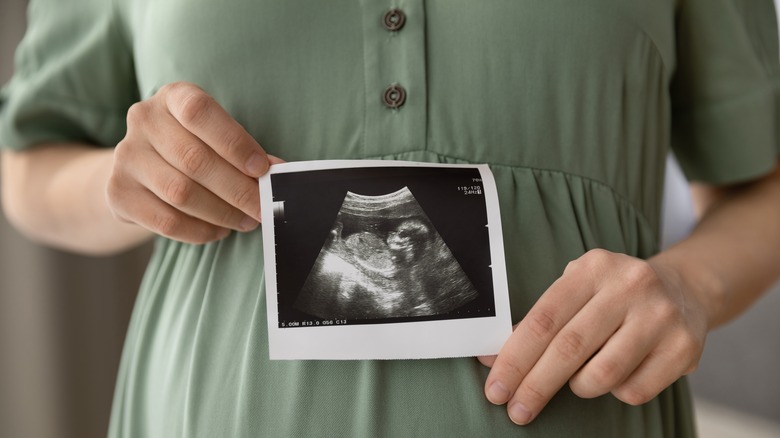When Can You Find Out The Gender Of Your Baby?
One of the first questions expectant couples have is whether they are having a boy or a girl. For some couples, learning the sex of their baby early is a major milestone of their pregnancy, celebrated in increasingly elaborate gender reveal parties. Others prefer to be surprised and learn their baby's gender at the moment of delivery.
There are some signs that could indicate what gender your baby is, according to What to Expect. For example, extreme nausea and vomiting can be caused by a condition called "hyperemesis gravidarum." This may be attributed to the levels of human chorionic gonadotropin or hCG, the so-called "pregnancy hormone." According to a 2002 study published in Obstetrics & Gynecology, hCG levels are higher in female fetuses compared with males. According to a 2008 study published in Proceedings of the Royal Society B: Biological Sciences, women who changed their diet by increasing their calorie intake and eating breakfast cereals had a higher probability of having a boy.
However, if you are eager to find out definitively what you are having, timing is important.
Are there tests that will tell you your baby's gender?
Starting at ten weeks, your doctor can perform a number of tests during your prenatal appointment that will not only reveal the gender of your baby but also let you know if anything may be wrong with the fetus.
The first of these is a non-invasive prenatal test (via MedlinePlus). This test will determine the risks of any genetic abnormalities that your baby could be born with, such as Down syndrome. It can also tell you what your baby's gender is, although you don't have to find out if you don't want to.
Also at ten or twelve weeks, you can elect to take a chorionic villus sampling, which involves taking a tissue sample from the placenta to test for any abnormalities (via Johns Hopkins Medicine). According to Healthline, chorionic villus sampling is best for women over the age of 35 who may have a family history of chromosomal issues. However, this test can present risks, including cramping, bleeding, preterm labor, and, in worst-case scenarios, miscarriage.
The Mayo Clinic also suggests amniocentesis, a test in which a small amount of amniotic fluid is removed from the uterus. This test can identify certain genetic conditions such as Down syndrome, and can usually be done between the 14th and 20th weeks of pregnancy. Healthline also notes that you can have an ultrasound done around 14 weeks to determine your baby's gender, although your doctor will usually schedule an ultrasound somewhere between 18 and 21 weeks.
Can the baby's heart rate predict gender?
There is an old wive's tale that suggests that heart rate can be a good way to determine the baby's gender (via Healthline). According to the story, if you listen to the baby's heartbeat during the first trimester and it's more than 140 beats per minute, it's a girl. A heart rate under 140 bpm signals that you're having a boy. However, as nice as it might be to think that the simple rhythm of the heart might be enough to tell you what you're going to be having, the truth is, there is no medical evidence to support this. A 2006 study published in Fetal Diagnosis and Therapy found that the average heart rate for boys in the first trimester was 154.9 bpm and 151.7 bpm for girls. Similarly, a 2018 study published in Acta Obstetricia et Gynecologica Scandinavica examined more than 10,000 pregnancies. The study found that, while the baseline heart rate for girls was marginally higher than that of boys, the differences were not significant enough to lend any credence to this theory.
The best way for couples to find out what they're having is to consult with their doctor and find the test or the method that works best for them (via Healthline). Some of the tests carry certain risks, and not all of them are for everyone. Talk with your healthcare professional when you reach around 10 weeks and decide what information you want to learn about your baby and the best, safest test to reach your goal.



